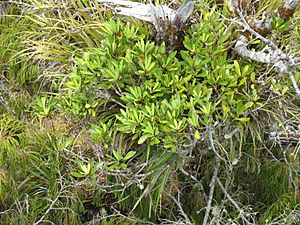Pittosporum kirkii facts for kids
Quick facts for kids Pittosporum kirkii |
|
|---|---|
 |
|
| Epiphytic specimen | |
| Conservation status | |
|
Invalid status (NZ TCS)
|
|
| Scientific classification | |
| Genus: |
Pittosporum
|
| Species: |
kirkii
|
Pittosporum kirkii is a special kind of shrub that stays green all year round. It can grow up to 5 meters (about 16 feet) tall. This plant has unique, thick, leathery leaves that are very smooth.
It's one of only four shrubs found only in New Zealand that often grows as an epiphyte. This means it grows on other plants, usually trees, instead of in the ground. Imagine it like a plant living in a treehouse! P. kirkii is often found high up in the branches of tall trees in old-growth forests. Sometimes, though, you can also spot it growing on the ground or even on rocks.
Contents
About Pittosporum Kirkii
Pittosporum kirkii is a fascinating plant. It's known for its smooth, shiny leaves and its ability to grow in unusual places. This plant is a perennial, meaning it lives for more than two years. Its leaves are described as "coriaceous," which means they are tough and leathery, a bit like thick leather.
How It Was Discovered
The plant was first noticed by a botanist named Thomas Kirk on Great Barrier Island in New Zealand. This was around 1868. He sent some plant samples and a short description to another famous botanist, Joseph Dalton Hooker, at Kew Gardens in England.
Hooker then worked with Kirk to officially name the plant. They decided to name it kirkii after Thomas Kirk, honoring his discovery. This official naming happened in 1869.
What It Looks Like
In 1869, Thomas Kirk described Pittosporum kirkii as a beautiful shrub with branches that spread out. Its branches are strong and grow upwards. The bark on its branches is a reddish-purple color.
The leaves grow in groups or in a circle. They are long and narrow, usually 2 to 5 inches long. They get narrower towards their base, where they connect to the stem with purple stalks. The leaves are very leathery, smooth, and pale green on top, with a lighter color underneath. The main vein on the leaf is thick and flat on the underside.
Flowers and Fruits
The flowers of P. kirkii grow in clusters of 3 to 7 at the ends of the branches. They have strong stalks that curve downwards. The petals are bright yellow and curve backwards.
After the flowers, the plant produces fruit capsules. These capsules stand upright in clusters. They are smooth, oval-shaped, and about 1 to 1.5 inches long. They are quite flat, but when they open to release seeds, the two halves curl in a unique way.
Reproduction
An important drawing by Cheeseman and others in 1914 was the first to show that P. kirkii has separate male and female plants. This is called dioecy. It means that some P. kirkii plants will only have male flowers, and other plants will only have female flowers. Both types of plants are needed for the plant to make seeds.
Where It Lives
Pittosporum kirkii is only found in certain parts of the North Island of New Zealand. Its range stretches from Mangonui in the Northland region down to Raetihi and the Matemateāonga Range south of Ohakune. It usually grows at an average height of about 471 meters (about 1,545 feet) above sea level. You can also find many of these plants on the islands of Great Barrier and Little Barrier, which are off the coast.
Current Status
Unfortunately, Pittosporum kirkii is currently listed as a species that is in decline. This means its numbers are going down, and it's not very common in any part of its natural habitat. Efforts are being made to protect this unique New Zealand plant.

